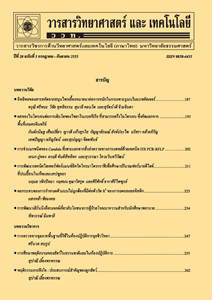การเพิ่มคุณค่าทางโภชนะของรำละเอียด เพื่อเป็นอาหารสัตว์เคี้ยวเอื้องด้วยยีสต์จากโรงงานผลิตเบียร์
Main Article Content
Abstract
The objective of this study was to evaluate nutritional values of rice bran fermented with brewer’s yeast (BY) at 0, 10, 20 and 30 % for 0, 1, 2, 3 and 4 weeks. The results showed that rice bran fermented with 30 % BY for 0-4 wks had highest (p < 0.05) crude protein in the range of 22.99 to 23.57 %, and rice bran fermented with 30 % BY for 0 wk had lowest (p < 0.05) dry matter (40.84 %). Rice bran fermented with 30 % BY for 4 wks had lowest (p < 0.05) NDF (20.40 %). Furthermore, rice bran without BY had highest (p < 0.05) fat in the range 16.11 to 16.96 %. The ruminal digestibility (in vitro) of dry matter of rice bran was highest (p < 0.05) when fermented with 30 % BY for 4 wks (73.85 %). It was concluded that nutritional value and dry matter digestibility of rice bran were maximized when fermented with BY at 30 % for 4 wks.
Article Details
References
Office of Agricultural Economics, 2016, The Situation of Major Agricultural Products and Trends in 2017, Ministry of Agriculture and Cooperatives, 215 p. (in Thai)
Krochta, J.M., Baldwin, E.A. and Nisperos-Carriedo, M.O., 1994, Edible Coating and Film Improve Food Quality, Technomic Publishing Company, Inc., Pennsylvania, 379 p.
White, T.W. and Hembry, F.G., 1985, Rice by-products in ruminant rations, Louisiana Agricultural Experiment Station, Baton Rouge, 18 p.
Pluemklang, A., 2011, Comparative Study on Production Performance of Dairy Cattle Fed Diets Containing Different Processed Rice Bran, Master Thesis, Kasetsart University, Bangkok, 87 p. (in Thai)
Kaewwongsa, W., 2011, Utilization of Fermented Cassava Pulp by Yeast (Saccharomyces cerevisiae) as a Protein Source for Meat Goats, Master Thesis, Suranaree University of Technology, Nakhon Ratchasima, 126 p. (in Thai)
Chanjula, P. and Pengnoo, A., 2011, Protein-Enriched Palm Kernel Cake by Yeast Fermented Process for Ruminant Feeds, Research Report, Prince of Songkla University, Songkla, 39 p. (in Thai)
Khampa, S., Koatdoke, U. and Itharat, S., 2010, Study on Enriches Value of Cassava Hay as Protein Source Replace Soybean Meal in Concentrate Containing High Level of Cassava Chip on Rumen Fermentation Protein Synthesis Efficiency in Cattle, Research Report, Rajabhat Maha Sarakham University, Maha Sarakham, 102 p. (in Thai)
Kamphayae, S., Kumagai, H., Angthong, W., Narmseelee, R. and Bureenok, S., 2017, Effects of different ratios and storage periods of liquid brewer’s yeast mixed with cassava pulp on chemical composition, fermentation quality and in vitro ruminal fermentation, Asian-Australas. J. Anim. Sci. 30: 470-478.
AOAC, 1990, Official Method of Analysis, 15th Ed., Association of Official Analytical Chemists, Arlington, VA.
Goering, H.K. and van Soest, P.J., 1970, Forage Fiber Analysis (Apparatus, Reagents, Procedures and Some Applications), U.S. Government Printing Office, Washington DC., 24 p.
Srichana, D., Suttitham, W., Thongsunthiah, P., Panja, P. and Jariyapamornkoon, N., 2014, Nutrients and ruminal digestibility of baby corn by-product silages under different harvesting methods, Thammasat Int. J. Sci. Technol. 19: 30-36.
van Zyl, W.H., Lynd, L.R., den Haan, R. and McBride, JE., 2007, Consolidated bioprocessing for bioethanol production using Saccharomyces cerevisiae, Adv. Biochem. Eng. Biotechnol. 108: 205-235.
Raimbault, M., 1998, General and microbiological aspects of solid substrate fermentation, Elect. J. Biotechnol. 1998: ej98021, 15 p.
Boonnop, K., 2008, Study on Production Process and Utilization of Yeast Fermented Cassava Chip Protein (Yefecap) on Rumen Fermentation, Microbial Protein Synthesis, and Nutrient Digestibilities in Ruminants, Master Thesis, Khon Kaen University, Khon Kaen, 89 p. (in Thai)


